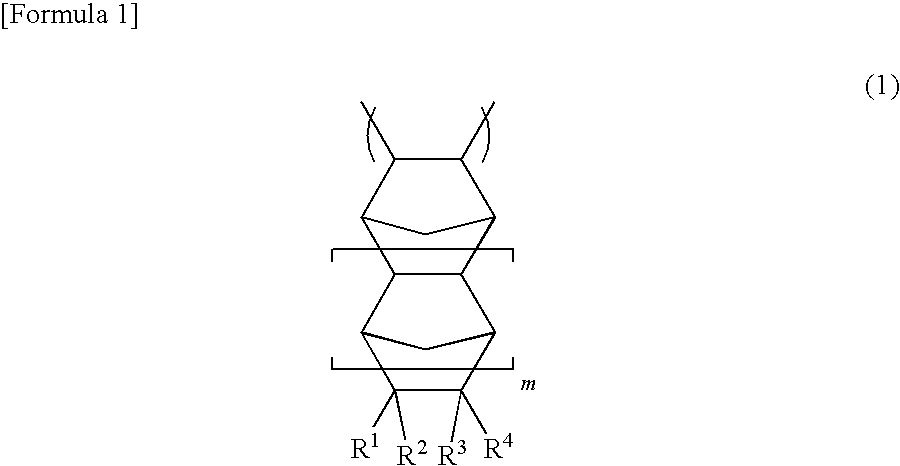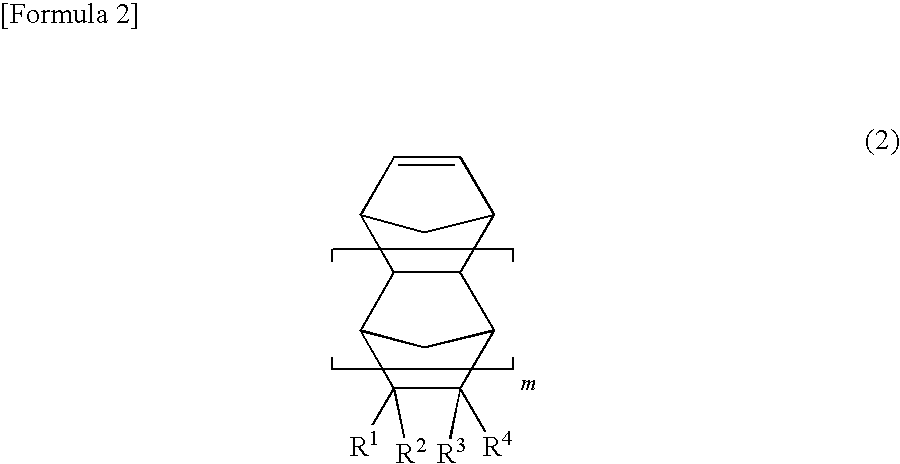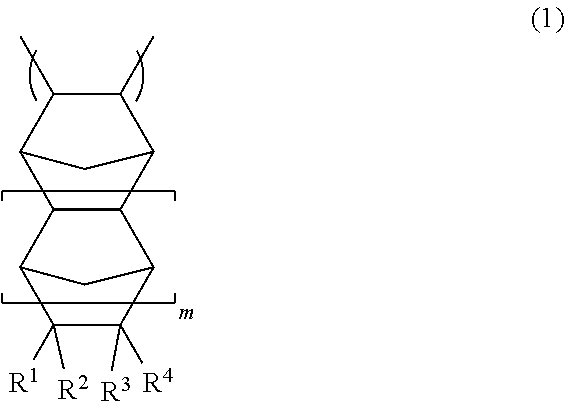Stretched film of addition polymer consisting of norbornene compound, process for producing the same and use thereof
a technology of addition polymer and norbornene compound, which is applied in the direction of ceramic shaping apparatus, manufacturing tools, etc., can solve the problems of affecting the stability of the film in high-temperature environments, affecting the stability of the film, and affecting the production efficiency of the product, etc., and achieves excellent film stability, small linear expansion coefficient, and simple production method
- Summary
- Abstract
- Description
- Claims
- Application Information
AI Technical Summary
Benefits of technology
Problems solved by technology
Method used
Image
Examples
reference example 1
(Polymerization)
[0162]0.77 part of (allyl)palladium(tricyclohexylphosphine) chloride and 1.14 parts of lithium tetrakis(pentafluorophenyl)borate were put into a nitrogen-purged glass reactor, and then 2 parts of toluene was successively added to give a catalyst liquid.
[0163]Next, 1,650 parts of bicyclo[2.2.1]hept-2-ene (NB; molecular weight=94), 915 parts of 5-ethylbicyclo[2.2.1]hept-2-ene (EtNB; molecular weight=122), 1,300 parts of styrene as a molecular weight-controlling agent, and 7,200 parts of toluene as a polymerization solvent were fed into a nitrogen-purged pressure glass container equipped with a stirrer, and the above catalyst liquid was added to it to start polymerization. After reacted at 45° C. for 4.5 hours, the polymerization liquid was poured into a large amount of methanol to thereby completely precipitate the polymer, which was then collected by filtration, washed and thereafter dried under reduced pressure at 50° C. for 18 hours to give 2,462 parts of a polymer ...
reference example 2
(Polymerization)
[0167]0.77 part of (allyl)palladium(tricyclohexylphosphine) chloride and 1.14 parts of lithium tetrakis(pentafluorophenyl)borate were put into a nitrogen-purged glass reactor, and then 2 parts of toluene was successively added to give a catalyst liquid.
[0168]Next, 1,650 parts of bicyclo[2.2.1]hept-2-ene (NB; molecular weight=94), 900 parts of 5-ethylidenebicyclo[2.2.1]hept-2-ene (EdNB; molecular weight=120), 1,200 parts of styrene as a molecular weight-controlling agent, and 7,200 parts of toluene as a polymerization solvent were fed into a nitrogen-purged pressure glass container equipped with a stirrer, and the above catalyst liquid was added to it to start polymerization. After reacted at 45° C. for 4.5 hours, the polymerization liquid was poured into a large amount of methanol to thereby completely precipitate the polymer, which was then collected by filtration, washed and thereafter dried under reduced pressure at 50° C. for 18 hours to give 2,423 parts of a pol...
example 1
[0172]The film of the addition polymer consisting of norbornene compounds (1) obtained in Reference Example 1 was set in an electric monoaxial stretcher (Imoto Seisakusho's trade name “IMC-16BE”). The sample chamber was purged with nitrogen, then heated up to 310° C., and the film was stretched by 2 times at a stretching speed of 55% / min.
[0173]The obtained stretched film dissolved completely in toluene, not leaving the film form, and therefore it was a non-crosslinked one. Its linear expansion coefficient was 41 ppm / ° C. Its light transmittance was 91%.
PUM
| Property | Measurement | Unit |
|---|---|---|
| boiling point | aaaaa | aaaaa |
| glass transition temperature | aaaaa | aaaaa |
| heat resistance | aaaaa | aaaaa |
Abstract
Description
Claims
Application Information
 Login to View More
Login to View More - R&D
- Intellectual Property
- Life Sciences
- Materials
- Tech Scout
- Unparalleled Data Quality
- Higher Quality Content
- 60% Fewer Hallucinations
Browse by: Latest US Patents, China's latest patents, Technical Efficacy Thesaurus, Application Domain, Technology Topic, Popular Technical Reports.
© 2025 PatSnap. All rights reserved.Legal|Privacy policy|Modern Slavery Act Transparency Statement|Sitemap|About US| Contact US: help@patsnap.com



